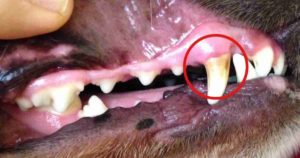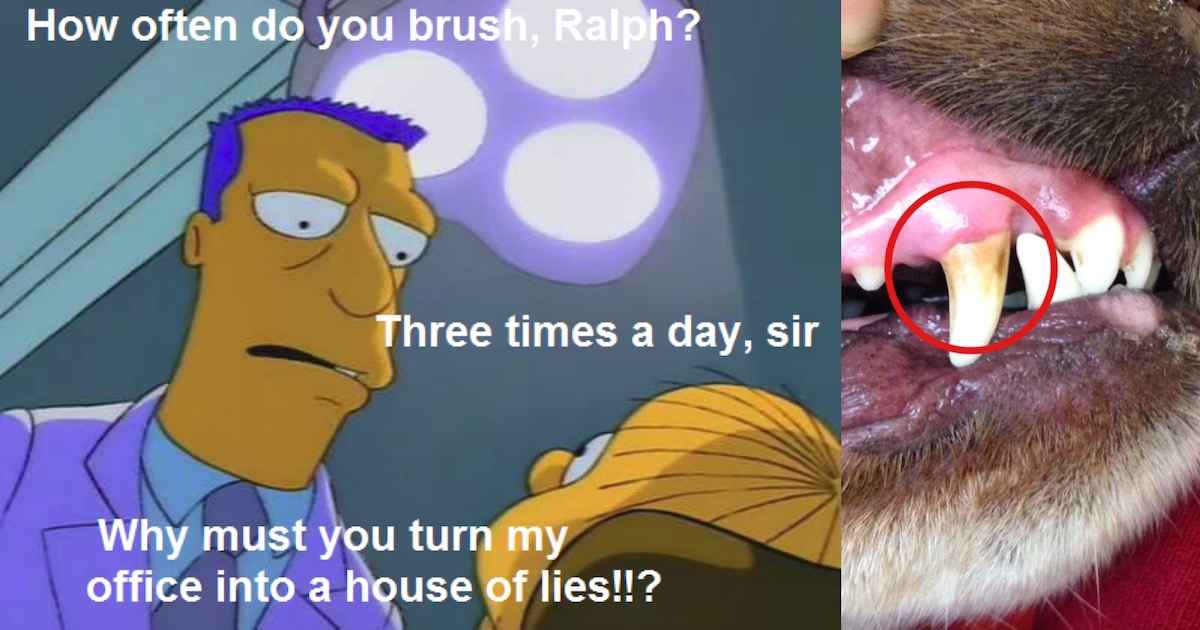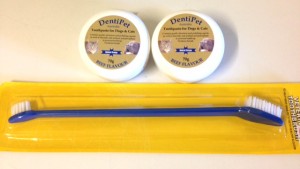Updated November 29, 2020
Every so often I’m reminded that I’m not doing such a great job. As part of a routine health check, I’ll be checking a dog’s teeth. “Wow,” I say, “Good job! You must give him a raw bone at least every week to get teeth this good.”
“No. I brush his teeth every day.”
I’m always caught by surprise but I shouldn’t be; more and more dog owners are doing it these days. People are now prepared to follow tooth brushing advice without even a hint of astonishment or laughter.
My Problems With Tooth Brushing
If tooth brushing is effective, why have I been so negative about it?
- I think about my busy home life and assume other people are just as short of time
- I know how difficult tooth brushing can be for dogs and owners
- I regularly see bad teeth despite regular tooth brushing
- I’m aware of research showing that less than 50% of even the most dedicated owners will do it
Fundamentally, I worry that by advising owners to perform a difficult task I’m just setting them up for failure. Especially when there are easier ways to keep dogs teeth clean. However, by avoiding tooth brushing I’m not offering the best solution for some dogs. It’s time I stop being so negative.
Can You Brush Cats’ Teeth?
Cats are another story. We value cats for their independence but when it comes to tooth brushing, that independence comes with teeth, claws and a lot of wriggle. I have seen plenty of people try, and even be successful for a while, but I have never seen sustained success in cats. It also helps that feline dental diets are a lot more effective than their canine equivalents.
So should you brush your dog’s teeth? There’s no ‘should’: it’s only one option along with raw bone feeding, dental chews and ultrasonic cleaning. Tooth brushing is also great to use along with dental chews for the parts of the teeth that the chews don’t clean.
How Long Does It Take?
Once your dog is accustomed to brushing (and doesn’t run away), it should take no longer than two minutes to brush their teeth. You only need to dwell on the outer tooth surface for a few seconds each.
How To Brush Dogs’ Teeth
It’s not rocket science.
Get a vet check first
The biggest reason most tooth brushing doesn’t work is that owners are trying to brush the unbrushable. Once dental disease is visible it’s usually too late, and will actually hurt. Most of the time we need to start by cleaning up the mouth under anaesthetic first.
Develop a routine
It’s perfectly OK to brush your dog’s teeth before a meal or a treat! The main goal is to remove the accumulated plaque from the previous 24 hours before it turns into tartar. Dogs generally don’t get food caught in their teeth unless they have a lot of gum recession.
Take it slowly
It’s a rare dog that will tolerate going straight from nothing to daily brushing. Build up your dog’s acceptance over weeks of slow, steady reward-based training.
Start young
Teaching to accept any meddling works best with puppies. However, don’t take this to mean your adult dog can’t learn as well. Just be patient, though you may have to accept that brushing isn’t for every dog.
Use the right gear
Dog owners find it hilarious that we have chicken and beef flavoured toothpastes but dogs don’t. Although I see the occasional dog that likes it, human toothpaste is unpleasant to most dogs.
As for brushes, I have yet to see a finger toothbrush that is good enough. You need soft bristles much like on a child’s brush, though we recommend and sell these inexpensive, nicely shaped pet brushes. Their other benefit is an offset handle so you don’t keep bopping poor Fido’s nose.
Get right to the back
Another common mistake is to not clean far enough back. Have a look at the video and you’ll see that in order to brush the molars your brush will have to go out of sight.
Only do the outside
Don’t worry about the video showing the inner surfaces; that’s for us to do. The tongue-side of dogs teeth doesn’t deteriorate as fast and is best left alone. Dogs really don’t like this area brushed.
Check your results
Any vet at a regular checkup can tell you how much success you’re having. They can also check the areas you can’t brush or even see. This is important: once gum recession starts, it’s very hard to stop.
How Often To Brush Dogs’ Teeth
The evidence shows that best results are achieved with brushing every one to two days. Here’s why I would do it every day:
- Dogs are happiest with predictable routines
- Owners will remember a daily event more easily
- If you miss one, it’s still OK

Once you go beyond two days, removable soft plaque mineralises into hard tartar. It’s extremely difficult to successfully remove this by brushing. That’s the brown stuff I’ve circled.
Finally, I’m grateful for a recent vet interview that made me rethink my prejudice against tooth brushing. In the same interview was another interesting fact. This vet sees at least one dog per week with tooth breakage or pieces stuck in teeth from bone feeding.
Our experiences tell a different story. We have always encouraged an approach to dental care that includes raw bones and we don’t see anything like this number of problems. Is it possible that by engaging with and informing people about bone feeding we are reducing the risk? I certainly hope so.
Further Reading
Harvey, C., Serfilippi, L., & Barnvos, D. (2015). Effect of frequency of brushing teeth on plaque and calculus accumulation, and gingivitis in dogs. Journal of Veterinary Dentistry, 32(1), 16-21.
Roudebush, P., Logan, E., & Hale, F. A. (2005). Evidence-based veterinary dentistry: a systematic review of homecare for prevention of periodontal disease in dogs and cats. Journal of Veterinary Dentistry, 22(1), 6-15.
Have something to add? Comments (if open) will appear within 24 hours.
By Andrew Spanner BVSc(Hons) MVetStud, a vet in Adelaide, Australia. Meet his team here.


